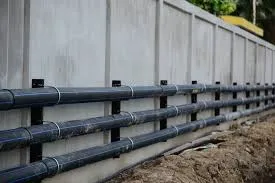Nov . 27, 2024 04:46 Back to list
6 Inch PVC Irrigation Pipe for Efficient Gated Water Distribution in Agriculture
The Importance of 6-Inch PVC Gated Irrigation Pipe in Modern Agriculture
Irrigation plays a crucial role in modern agriculture, providing the necessary water supply to crops and ensuring optimal growth and productivity. Among various irrigation systems available, the 6-inch PVC gated irrigation pipe has become increasingly popular due to its efficiency, durability, and cost-effectiveness. This article explores the significance of the 6-inch PVC gated irrigation pipe in farming, its advantages, and some best practices for its use.
What is a 6-Inch PVC Gated Irrigation Pipe?
A 6-inch PVC gated irrigation pipe is a type of piping specifically designed for controlled water distribution in agricultural fields. Typically made of durable PVC (polyvinyl chloride), these pipes feature built-in gates or outlets at regular intervals. This design allows water to flow out in a controlled manner, ensuring even distribution across a field or crop area. The 6-inch diameter strikes a balance between adequate water flow and ease of manipulation, making it suitable for various agricultural sizes and types.
Advantages of Using 6-Inch PVC Gated Irrigation Pipe
1. Durability and Longevity PVC pipes are known for their resistance to corrosion and chemicals, which makes them ideal for carrying water in agricultural settings. Unlike metal pipes that can rust and degrade over time, PVC pipes maintain their integrity, providing long-term reliability.
2. Cost-Effectiveness The initial installation cost of PVC piping may be higher than some alternatives; however, its longevity and low maintenance needs make it a cost-effective choice over time. Farmers can save on replacement and repair costs associated with traditional materials.
3. Efficient Water Distribution The gated design allows for precise control over water flow, enabling farmers to distribute water evenly across their fields. This uniformity helps prevent overwatering in some areas while ensuring others receive adequate moisture, ultimately leading to healthier crops.
4. Easy Installation and Maintenance PVC pipes are lightweight and can be easily transported and handled, making installation more straightforward. They can be assembled quickly with a variety of fittings and joints, reducing the labor time required for setup.
5. Environmental Benefits By promoting effective water distribution and reducing waste, 6-inch PVC gated irrigation pipes contribute to more sustainable farming practices. Efficient irrigation systems help conserve water resources, which is vital in regions facing water scarcity.
6 inch pvc gated irrigation pipe

Best Practices for Using 6-Inch PVC Gated Irrigation Pipes
To maximize the benefits of 6-inch PVC gated irrigation pipes, farmers should consider implementing the following best practices
1. Proper Design and Layout The effectiveness of an irrigation system greatly depends on its design. Farmers should assess their land’s topography and crop needs to create an optimal layout for the PVC pipes. This includes determining the appropriate spacing between gates to ensure proper water distribution.
2. Regular Maintenance While PVC is low maintenance, regular checks for blockages, leaks, and the integrity of joints are crucial. Farmers should establish a routine maintenance schedule to ensure the system operates smoothly throughout the growing season.
3. Monitoring and Adjustments Farmers should monitor soil moisture levels and crop health to adjust the flow rate and operational times of the irrigation system as needed. This proactive approach allows for timely interventions and optimizes water usage.
4. Education and Training Understanding the technical aspects of the irrigation system is vital. Farmers and their employees should receive training on how to operate and maintain the PVC gated pipes effectively.
5. Integration with Other Systems Combining the gated PVC irrigation system with other agricultural technologies, such as moisture sensors and automated irrigation controls, can enhance efficiency and further reduce water waste.
Conclusion
The 6-inch PVC gated irrigation pipe represents a significant advancement in irrigation technology. Its durability, efficiency, and cost-effectiveness make it a preferred choice for farmers seeking to improve their irrigation systems. By understanding the advantages and implementing best practices, farmers can ensure sustainable agricultural practices that contribute to increased productivity and environmental stewardship. As global agricultural demands continue to rise, innovations like these will remain vital in shaping a more efficient and sustainable future for farming.
-
High-Quality PPR Pipes and Fittings Durable ERA PPR & PVC PPR Solutions
NewsJul.08,2025
-
Black HDPE Cutting Board - Durable, Non-Porous & Food Safe HDPE Plastic Cutting Board
NewsJul.08,2025
-
High-Quality CPVC Panel Durable HDPE & PVC Panels Supplier
NewsJul.08,2025
-
Double PE Welding Rod Supplier - High Strength, Durable & Versatile Welding Solutions
NewsJul.07,2025
-
High-Quality PVC-O Pipe Supplier Durable 75mm PVC Pipe & Connections Leading PVC Pipe Company
NewsJul.07,2025
-
HDPE Drainage Pipe Supplier – Durable & Corrosion-Resistant Solutions
NewsJul.06,2025

